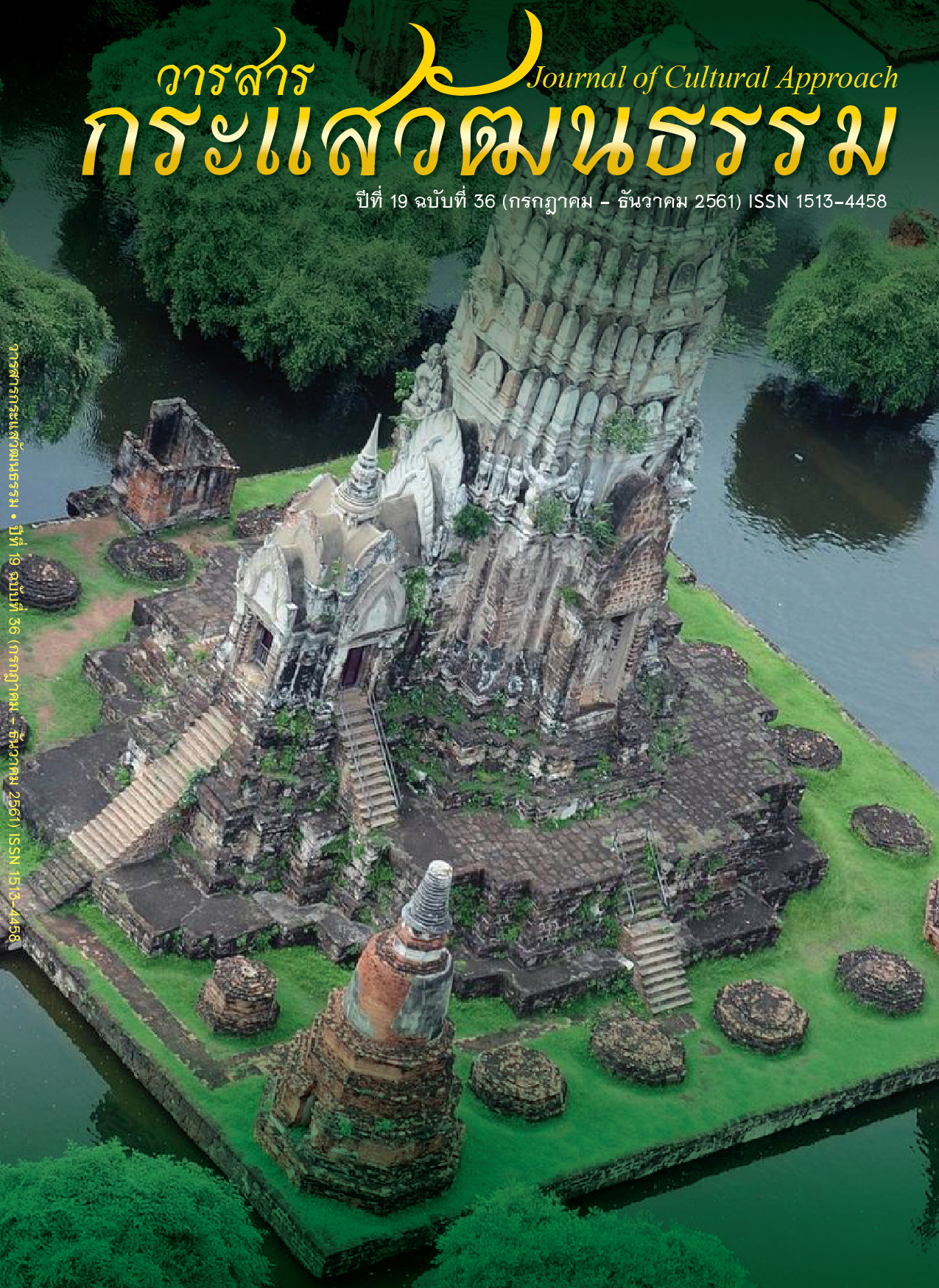ความท้าทายของชุมชนเชิงมรดกทางวัฒนธรรมต่อการพัฒนาแหล่งท่องเที่ยว อย่างยั่งยืน
Main Article Content
บทคัดย่อ
การท่องเที่ยวอย่างยั่งยืนเป็นกระแสการส่งเสริมการท่องเที่ยวที่ได้รับการยอมรับกันอย่างแพร่หลายในความพยายามที่จะรักษาการท่องเที่ยวในพื้นที่ต่างๆ ให้สามารถสร้างประโยชน์ต่อแหล่งท่องเที่ยวได้ยาวนานที่สุด ซึ่งแหล่งท่องเที่ยวชุมชนเชิงมรดกทางวัฒนธรรมถือเป็นแหล่งท่องเที่ยวประเภทหนึ่งที่ได้รับความสนใจจากนักท่องเที่ยวเป็นจำนวนมากในปัจจุบัน แต่เป็นแหล่งท่องเที่ยวที่ทรัพยากรการท่องเที่ยวมีความเปราะบางและง่ายต่อการถูกทำลายสูงและรวดเร็ว การเสนอรูปแบบการจัดการแหล่งท่องเที่ยวดังกล่าวบนพื้นฐานความท้าทายจึงเป็นความพยายามที่จะชี้ให้เห็นถึงปัจจัยต่างๆ ที่เกี่ยวข้องและมีความสำคัญต่อการนำมาวางแผนเพื่อการพัฒนาแหล่งท่องเที่ยวชุมชนเชิงมรดกทางวัฒนธรรมให้เกิดความยั่งยืนเป็นสำคัญ
Article Details
รูปแบบการอ้างอิง
Sangchumnong, A. (2018). ความท้าทายของชุมชนเชิงมรดกทางวัฒนธรรมต่อการพัฒนาแหล่งท่องเที่ยว อย่างยั่งยืน. วารสารกระแสวัฒนธรรม, 19(36), 82–91. สืบค้น จาก https://so02.tci-thaijo.org/index.php/cultural_approach/article/view/153916
ประเภทบทความ
Academic Article
Proposed Creative Commons Copyright Notices
1. Proposed Policy for Journals That Offer Open Access
Authors who publish with this journal agree to the following terms:
- Authors retain copyright and grant the journal right of first publication with the work simultaneously licensed under a Creative Commons Attribution License that allows others to share the work with an acknowledgement of the work's authorship and initial publication in this journal.
- Authors are able to enter into separate, additional contractual arrangements for the non-exclusive distribution of the journal's published version of the work (e.g., post it to an institutional repository or publish it in a book), with an acknowledgement of its initial publication in this journal.
- Authors are permitted and encouraged to post their work online (e.g., in institutional repositories or on their website) prior to and during the submission process, as it can lead to productive exchanges, as well as earlier and greater citation of published work (See The Effect of Open Access).
Proposed Policy for Journals That Offer Delayed Open Access
Authors who publish with this journal agree to the following terms:
- Authors retain copyright and grant the journal right of first publication, with the work [SPECIFY PERIOD OF TIME] after publication simultaneously licensed under a Creative Commons Attribution License that allows others to share the work with an acknowledgement of the work's authorship and initial publication in this journal.
- Authors are able to enter into separate, additional contractual arrangements for the non-exclusive distribution of the journal's published version of the work (e.g., post it to an institutional repository or publish it in a book), with an acknowledgement of its initial publication in this journal.
- Authors are permitted and encouraged to post their work online (e.g., in institutional repositories or on their website) prior to and during the submission process, as it can lead to productive exchanges, as well as earlier and greater citation of published work (See The Effect of Open Access).
เอกสารอ้างอิง
[1] Birukou, A., Blanzieri, E., Giorgini, P. & Giunchiglia, F. (2009). A Formal Definition of Culture. University of Trento.
[2] Earth Summit Conference. (2000). Sustainable Tourism – Turning the Tide. Retrieved from www.earthsummit2002.org.
[3] George, R. (2001). Marketing South African Hospitality and Tourism. South Africa: Oxford Press.
[4] Howie, F. (2003). Managing the Tourist Destination. London: Thomson Learning.
[5] Jemieson, W. (2000). The Challenge of Sustainable Community Cultural Heritage Tourism. Asian Institute of Technology. Retrieved August 2, 2016, from https://www.ucalgary.ca.
[6] McKercher, B. & Ho, P. S .Y. (2006). Assessing the Tourism Potential of Smaller Cultural and Heritage Attractions. Journal of Sustainable Tourism, 14(5), 473-488.
[7] Ministry of Natural Resources and Environment. (2013). Introduction to the Fundamentals of Sustainable Development. Bangkok: Amarin Printing & Publishing Public Co. Ltd.
[8] Ministry of Tourism and Sport. (2015). Thailand Tourism Strategies 2015 – 2017, Retrieved from https://www.mots.go.th/ewt_dl_link.php?nid=7114.
[9] Qu, H., Lisa, H. K., & Holly, H. I. (2011). A Model of Destination Branding: Integrating the Concepts of the Branding and Destination Image. Tourism Management, 32(3), 465-476.
[10] Sanglimsuwan, Karnjana. & Sanglimsuwan, Sarunya. (2012). Sustainable Cultural Heritage Tourism. Executive Journal, 32(4), 139-146.
[11] Tansukhanan, Pranorm. (2016). Urban Conservation. Bangkok: Chulalongkorn University Press
[12] The United Nations Educational, Scientific and Cultural Organization: UNESCO. (2008). Operational Guideline for the Implemention of the World Heritage Convention. Paris: UNESCO World Heritage Center.
[13] Wannasiri, Niyaphan. (2007). Manutsayawitthaya Sangkhom Lae Watthanatham. Social Anthropology and Culture. Bangkok: Expernet Co., Ltd. (in Thai)
[14] World Trade Organization: WTO. (2004). Indicators of Sustainable Development for Tourism Destinations: A Guidebook. Printed by the World Tourism Organization: Madrid, Spain.
[2] Earth Summit Conference. (2000). Sustainable Tourism – Turning the Tide. Retrieved from www.earthsummit2002.org.
[3] George, R. (2001). Marketing South African Hospitality and Tourism. South Africa: Oxford Press.
[4] Howie, F. (2003). Managing the Tourist Destination. London: Thomson Learning.
[5] Jemieson, W. (2000). The Challenge of Sustainable Community Cultural Heritage Tourism. Asian Institute of Technology. Retrieved August 2, 2016, from https://www.ucalgary.ca.
[6] McKercher, B. & Ho, P. S .Y. (2006). Assessing the Tourism Potential of Smaller Cultural and Heritage Attractions. Journal of Sustainable Tourism, 14(5), 473-488.
[7] Ministry of Natural Resources and Environment. (2013). Introduction to the Fundamentals of Sustainable Development. Bangkok: Amarin Printing & Publishing Public Co. Ltd.
[8] Ministry of Tourism and Sport. (2015). Thailand Tourism Strategies 2015 – 2017, Retrieved from https://www.mots.go.th/ewt_dl_link.php?nid=7114.
[9] Qu, H., Lisa, H. K., & Holly, H. I. (2011). A Model of Destination Branding: Integrating the Concepts of the Branding and Destination Image. Tourism Management, 32(3), 465-476.
[10] Sanglimsuwan, Karnjana. & Sanglimsuwan, Sarunya. (2012). Sustainable Cultural Heritage Tourism. Executive Journal, 32(4), 139-146.
[11] Tansukhanan, Pranorm. (2016). Urban Conservation. Bangkok: Chulalongkorn University Press
[12] The United Nations Educational, Scientific and Cultural Organization: UNESCO. (2008). Operational Guideline for the Implemention of the World Heritage Convention. Paris: UNESCO World Heritage Center.
[13] Wannasiri, Niyaphan. (2007). Manutsayawitthaya Sangkhom Lae Watthanatham. Social Anthropology and Culture. Bangkok: Expernet Co., Ltd. (in Thai)
[14] World Trade Organization: WTO. (2004). Indicators of Sustainable Development for Tourism Destinations: A Guidebook. Printed by the World Tourism Organization: Madrid, Spain.


